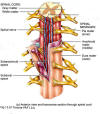|
Blasts:
Immature blood cells usually found only in
the bone marrow.


Click to
Enlarge
Click to Enlarge
Lymphoblasts
Myeloblasts
In
leukemias, precursor cells such as blasts
are often found in the peripheral blood. It
is important to differentiate these cells to
help determine the type of leukemia and
treatment. Most of the time the blast type
can be accurately predicted based on
morphology alone. The key features are the
chromatin pattern and the character of the
cytoplasm. Lymphoblasts and myeloblasts
generally have round to oval nuclei with
nucleoli; however, the chromatin of
lymphoblasts is coarse with a tendency to
aggregate into masses. In contrast,
myeloblasts have fine, delicate chromatin. |
|
Blood-brain
barrier
Special characteristics of the capillary
walls of the brain that prevent potentially
harmful substances from moving out of the
bloodstream into the brain or cerebrospinal
fluid. |
|
Demylination
The removal or
destruction of the healthy mylin sheath
surrounding nerve tissue. |
|
Direct Antigen Test
The direct antigen
test uses immunologic laboratory procedures
to detect the prescence of an antigen (in
this case a specific component of the
bacterial cell), in the spinal fluid of the
patient. This test method has several
advantages: One, it is generally very
specific as to the type of organism present.
Two, it is rapid and greatly assists the
physician in making a diagnosis, and hence
prescribing the correct therapy. For a more
detailed explanation, click here. |
Diuresis
Secretion and passage of large amounts of
urine. |
|
Endemic (as applied to diseases)
As it refers to
microbiological diseases, when an organism
persists in a large population in a
subclinical (asymptomatic) state, it is said
to be endemic to that area. As with
hepatitis A, regions where food and drink
may be contaminated with human feces, large
numbers of people have a high potential for
exposure. Some will develop symptoms and
some will be carriers without symptoms.
|
|
Hemarthrosis
Blood that has
accumulated inside a joint due to
hemorrhage from injury. |
|
Hemorrhage
Severe bleeding,
either internally or externally. |
|
Hemostasis
A process whereby bleeding is stopped
|
|
Hypercellularity
An increased number of cells in any location
but especially in the bone marrow. |
|
Hypervolemia
An abnormal increase in the volume of
circulating blood. |
|
Immunocompromised
An immune system
unable to respond to pathogens or tissue
damage. This may be due to disease,
immunosuppressive drugs, or a genetic
disorder. |
|
Infectious Disease
Although many complex
factors surround the definition of
infectious disease, some generalizations can
be made. An infection can be defined as a
state in which microorganisms, bacteria,
viruses, fungi and parasites, survive and
reproduce in the host's tissues. In many
instances no noticeable changes (or
symptoms) are apparent. When the organism
produces sufficient tissue damage through
many different mechanisms, the definition of
infectious disease then applies. As in
hepatitis, liver cells are invaded and
damaged by the virus. Symptoms then result
and the cause can
be determined
through clinical examination and laboratory
tests. |
|
Lymphoblasts
Immature lymphocytes usually found only in
the bone marrow.

Click to
Enlarge |
|
Meninges
The three
membranes that cover the brain and spinal
cord. The membranes consist of the dura
mater (external), arachnoid (middle), and
pia mater (internal).

Click to
Enlarge |
|
Knee flexion
(flekshun)
The act of
bending the knee, in contrast to the act of
extending the knee. |
Organomegaly
The enlargement
of visceral organs. |
|
Platelets
Small, round to
oval discs (2-4 um) found in the blood.
Platelets respond to injuries to the vessel
wall by adhering to the injured site and
forming a plug. This platelet plug
initiates the clotting process which forms a
fibrin clot. |
|
Pneumonia
An infection
that occurs when fluid and cells collect in
the lungs. Pneumonia can be caused by
bacteria, viruses, and other pathogenic
organisms. It can also be caused by
chemicals or other irritants. |
|
Pus
A thick
whitish-yellow fluid which results from the
accumulation of white blood cells (WBCs),
liquefied tissue and cellular debris. Pus is
commonly a site of infection or foreign
material in the body. |
|
Petechiae
Tiny red spots
in the skin which do not blanch when pressed
upon. They result from red blood leaking
from capillaries. |
|
Remission
Disappearance of
the signs and symptoms of cancer or other
disease. When this happens, the disease is
said to be "in remission." A remission can
be temporary or permanent.
|
|
Urine
Clearance Test
In basic
terms, clearance tests measure the overall
effectiveness of the collective efforts of
the kidney to excrete waste products.
Several substances such as creatinine and
a sugar polymer
called insulin can be used to measure the
kidney's clearance capacity. The test
measures the volume of plasma that is
cleared of the test substance per unit of
time, usually in milliliters per minute over
a 24 hour period. In this patient's case,
the test will be performed at least twice:
the first at the beginning of her hospital
stay as a baseline. Then again in the
recovery period to give the nephrologist
evidence the kidneys are regaining their
normal functional duties. |
|
Upper lobe infiltrate
A penetration of infectious material in the
superior (upper) division (lobe) of the
lung. |
|
Valgus
The distal position of a body part that is
bent outward. |
|
Varus
The distal position of a body part that is
bent inward. |